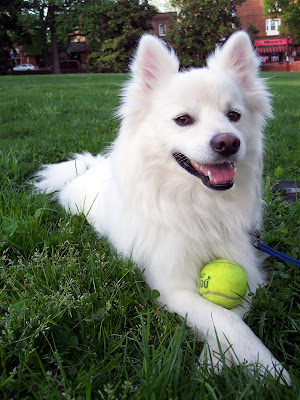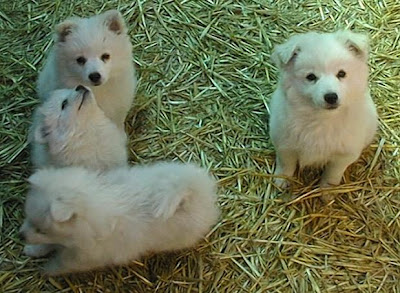The American Eskimo Dog (affectionately called ‘Eskie’ or by the German name ‘spitz’) actually descends from several German breeds such as the Pomeranian and Keeshond. It is not a close relative of the Alaskan Husky. The American Eskimo Dog was brought to America by German settlers in the early 20th century and became a popular circus performer. One Eskie named ‘Stout’s Pal Pierre’ became famous by walking the tightrope. Circuses popularized the breed by selling Eskie puppies after the show. The American Eskimo Dog was finally recognized by the American Kennel Club in 1994.
.
The American Eskimo is a small to medium-size Nordic-type dog, which looks like a miniature Samoyed. There are three varieties: the toy, miniature, and standard. The American Eskimo has a wedge-shaped head with muzzle and skull about the same length. It has erect triangular-shaped ears, and a heavily plumed tail curled over the back. The coat is always white, or white with biscuit or cream markings. Their skin is pink or gray. The coat is heavy around the neck, creating a ruff or mane, especially in males. The breed is slightly longer than it is tall.
.
- Pictures of their dogs listed by generation. Pennsylvania.
- Pictures of their dogs and litter announcements. SeaTac, Washington.
- Raising toy and miniature sizes. Photographs, pedigrees, breed history, and an article on health issues. Perryville, Missouri.
- Breeder of toy and miniature companion and show dogs. Pictures of the dogs and a list of their accomplishments. Calgary, Alberta, Canada.
- Breeding toy dogs. Photographs of their dogs and breeding schedule. Stroud, Oklahoma.
- Breeding standards, miniatures, and toys. Breed information and litter announcements. Sherwood, Michigan.
- Pictures, litter announcements, and show news. Woodinville, Washington.
- Breeding for show and companionship. An explanation of their holistic processes for raising dogs and a list of dogs from their bloodline. Eastern Pennsylvania.
- Small breeder of miniatures and toys. Pictures and information on the breed. Minneapolis, Minnesota.
- Breeding standard sized show and companion puppies. Litter announcements, pedigrees, and pictures of the dogs. Ontario, Canada
- Includes show news, photo gallery and litter announcements. Hanmer, Ontario, Canada.
- Raising dogs for conformation, performance, and companion homes. Pictures, pedigrees, breed standard, and agility photographs.
- Breeder of standard show and companion dogs with photographs. Naples, Florida.
- Breed information, kennel history, and litter announcements. Wisconsin.
- Schedule, pedigrees, and information on the breed standard. Also breed Chinese Cresteds and Ragdoll cats. Anderson, South Carolina.
- Photographs of their dogs and contact information. Kincardine, Ontario, Canada.
- Breeding miniatures and toys. Scrapbook and birth announcements. Sangudo, Alberta, Canada.
- Photographs, pedigrees, breeding plans, and health links. Massachusetts.
- Breeding miniatures in Boise, Idaho. Photographs of their dogs and breeding schedule.
- Breed description and history, photographs, pedigrees, and news. Kalamazoo, Michigan.
.





























































